Hand Crank Emergency Flashlight with Radio
May 13, 2011 by admin
Filed under Survival Tools
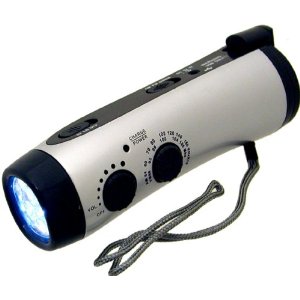 Kaito Emergency Hand Crank Dynamo 5-LED Flashlight with AM/FM Radio
Kaito Emergency Hand Crank Dynamo 5-LED Flashlight with AM/FM Radio
Site Price: $14.99
When a disaster strikes, you never know if you’ll have enough batteries or a power supply. This flashlight uses a hand crank to boost its power. Simply crank the flashlight for 1 minute and have light for 30. The radio has a siren, so you can hear the news out in the world. There is also a USB cable included so that cell phones, with a USB connection, can be charged.
AM/FM Radio with Solar Power Flashlight and Cell Phone Charger
March 23, 2011 by admin
Filed under Survival Tools
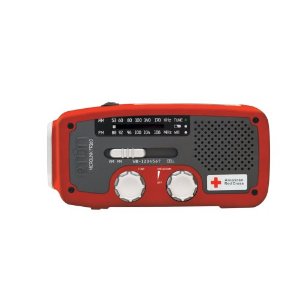 Eton American Red Cross Microlink Self-Powered AM/FM/NOAA Weather Radio with Flashlight, Solar Power and Cell Phone Charger
Eton American Red Cross Microlink Self-Powered AM/FM/NOAA Weather Radio with Flashlight, Solar Power and Cell Phone Charger
This little AM/FM radio can run off of solar power or a hand crank, making it perfect for after a disaster. There is also a USB inlet on the side, so that you can charge your phone or other electronic device off of it. There is also a flashlight, made up of 3 built-in LEDs on the side.
The Ultimate Guide to Building a Disaster Kit: Essentials and Must-Haves
June 19, 2023 by admin
Filed under Disaster Kits, General Emergency Supplies
Preparing for a disaster is essential to protect yourself and your loved ones. Building a well-stocked and comprehensive disaster kit is a crucial step towards being prepared. In this guide, we will provide practical tips, actionable advice, and reliable resources to help you build the ultimate disaster kit.
- Start with the Basics:
- Water Storage: Aim to store at least one gallon of water per person per day for a minimum of three days. Consider adding water purification tablets or a water filtration system.
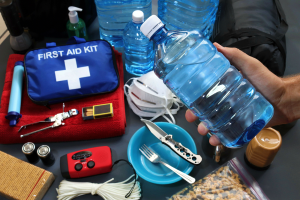
- Long Term Food: Opt for non-perishable items like canned goods, granola bars, and dried fruits. Don’t forget a manual can opener.
- Medications and First Aid: Include a well-stocked first aid kit, prescription medications, and any necessary medical supplies.
- Shelter and Clothing:
- Shelter: Have a tent, sleeping bags, or emergency blankets to provide shelter during evacuation or emergencies.
- Clothing: Pack durable clothing suitable for various weather conditions, including rain gear, warm layers, and sturdy shoes.
- Tools and Supplies:
- Flashlights and Batteries: Keep several flashlights with extra batteries readily available.
- Multi-Tools: A versatile tool that combines various functions like pliers, a knife, and a screwdriver can be indispensable.
- Whistle and Signal Mirror: These can help attract attention if you’re lost or need to signal for help.
- Duct Tape and Plastic Sheeting: These items can be used for temporary repairs and improvisation.
- Cash: Keep a small amount of cash in case ATMs are unavailable during a disaster.
- Communication and Documentation:
- Battery-powered or Hand Crank Radio: Stay informed about the latest news and emergency updates.
- Cell Phone Charger: Have a portable charger or a solar-powered charger to keep your cell phone operational.
- Important Document Storage: Gather important documents like identification, insurance policies, and contact information in a waterproof container.
- Personal Hygiene and Sanitation:
- Personal Hygiene Items: Include items such as toothbrushes, toothpaste, hand sanitizer, and feminine hygiene products.
- Sanitation Supplies: Stock up on toilet paper, trash bags, and disinfectant wipes to maintain cleanliness.
- Additional Considerations:
- Pet Supplies: If you have pets, include food, water, medications, and any necessary documents.
- Entertainment and Comfort: Include books, playing cards, or other small games to keep spirits high during stressful times.
- Emergency Contact List: Write down important phone numbers and addresses in case your electronic devices are not accessible.
Reliable Resources:
- Ready.gov: The official website of the U.S. Department of Homeland Security provides comprehensive information on disaster preparedness.
- American Red Cross: Visit redcross.org for a wealth of resources, including emergency planning guides and first aid tips.
- FEMA: The Federal Emergency Management Agency offers valuable guidance on disaster preparedness and response at fema.gov.
Building a disaster kit is an essential step in preparing for emergencies. By following the practical tips, actionable advice, and utilizing reliable resources provided in this guide, you can create an ultimate disaster kit that will help you and your loved ones stay safe and resilient during challenging times. Remember to regularly check and update your kit to ensure its effectiveness. Being prepared is the key to successfully navigating through any disaster or emergency.
Why Emergency Personnel Safety Equipment Must Be High-Quality
February 4, 2023 by Guest Author
Filed under General Emergency Supplies
When flying in an airplane, if an emergency occurs, it is important to place the oxygen mask over your own face before you assist someone else. This is because if you are attempting to help another person but faint due to lack of oxygen, you will do them no good. In much the same way, rescue workers need proper safety equipment when they work to assist citizens. If they do not have the proper equipment, their ability to lend aid becomes limited. Therefore, it is imperative they are provided with high-quality safety gear.
Harnesses:
Rescue workers require high-quality harnesses when performing rescues. For example, the brave people who risk their lives hanging from helicopters in an attempt to pluck some wayward soul from raging floodwaters require proper safety harnesses in order to perform their life-saving job.
Ropes:
Another piece of necessary equipment is a well-made rope. Many accident scenarios require rescue workers to use a rope when aiding another person. When workers are in harnesses, they sometimes use ropes as a safety line in order to remain safe.
Connectors and hooks:
The harnesses and ropes are great, but without connectors and hooks, they are useless. Connectors keep rescue workers firmly attached to their harnesses and allow them to hook on victims as they assist them.
Jackets:
A rescue worker’s visibility to those around them is very important. For example, a worker aiding in the event of an accident should wear a reflective coat or vest to make themselves easily visible to victims.
Flashlights:
There are many varieties of rescue work, and almost all of them will benefit from a high-quality flashlight. After natural disasters, first responders are likely to deal with power outages. A good flashlight will prove invaluable in such a situation.
Radios:
Communication is vital among rescue workers. Creating a calm and controlled environment is one of the first priorities of rescue personal. Knowing the location of other rescue workers or coordinating rescue efforts is also imperative.
Hard hats or helmets:
In some situations, rescue personal would benefit from hard hats or helmets. Helmets are often worn by emergency workers. Many of them have protection for the eyes built-in. Hard hats are necessary on any sites where the potential of falling debris exists.
Rescue workers serve their communities selflessly. High-quality safety gear keeps them safe as they seek to keep us safe. If their equipment is old or worn out, workers become limited in their rescue performance. For that reason, all rescue workers require high-quality safety gear for any job that presents itself.
Eric Blair writes about construction safety and the importance of having proper equipment from a reputable dealer like Fall Protection USA.
Use of Iodide in a Disaster: How and Why to use it
January 31, 2023 by admin
Filed under General Emergency Supplies
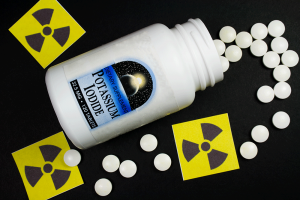 Iodide is a crucial element that plays a significant role in maintaining human health during disaster situations. The element is used to prevent the absorption of radioactive iodine by the thyroid gland, which can cause severe health problems such as radiation sickness, cancer, and thyroid disorders.
Iodide is a crucial element that plays a significant role in maintaining human health during disaster situations. The element is used to prevent the absorption of radioactive iodine by the thyroid gland, which can cause severe health problems such as radiation sickness, cancer, and thyroid disorders.
In a disaster situation, radioactive iodine can be released into the air, water, and soil due to nuclear accidents or the detonation of nuclear weapons. When inhaled or ingested, radioactive iodine can be absorbed by the thyroid gland, leading to long-term health consequences.
To prevent the absorption of radioactive iodine, iodide is used in the form of potassium iodide (KI) or sodium iodide (NaI). These iodide salts are taken orally and help to saturate the thyroid gland, preventing the uptake of radioactive iodine.
One of the key reasons for using iodide in disaster situations is that it is a simple and effective way to protect the thyroid gland. Unlike other protective measures, such as evacuation or sheltering in place, iodide can be taken quickly and easily, making it a reliable option in emergency situations.
Iodide is also readily available and affordable, making it an accessible option for people in disaster-stricken areas. Additionally, iodide is well-tolerated by the human body and has been used for decades as a dietary supplement to prevent iodine deficiency.
However, it is important to note that iodide is not a cure-all solution and should not be relied upon as the sole means of protection against radioactive iodine. Iodide is most effective when taken before or immediately after exposure to radioactive iodine. Therefore, it is essential to have access to iodide as soon as possible after a disaster event.
In addition to being used for individual protection, iodide can also be used in a larger scale in disaster situations. For example, iodide can be added to public water supplies to protect the entire population from exposure to radioactive iodine.
In order to maximize the effectiveness of iodide in a disaster situation, it is crucial to have a well-planned and coordinated response. This includes having adequate supplies of iodide on hand, clear communication channels to disseminate information to the public, and trained personnel to manage the distribution and administration of iodide.
It is also important to consider the specific needs of different populations, such as children, pregnant women, and those with underlying medical conditions. For example, children may require lower doses of iodide compared to adults, and pregnant women may need to take additional precautions due to the potential risks to the developing fetus.
In conclusion, iodide is a critical component of emergency preparedness and response in disaster situations. Its ability to prevent the absorption of radioactive iodine by the thyroid gland makes it a simple and effective means of protecting human health. However, the effective use of iodide in disaster situations requires careful planning, coordination, and consideration of the specific needs of different populations.
Earthquake Emergency Preparedness Kit
December 21, 2011 by admin
Filed under Earthquake Survival Kits, Hurricane Survival Kits
This handy emergency preparedness kit has a feature that none of the other available disaster kits offers: a toilet! Do we really consider where we’d leave our refuge during a disaster, when the power is out and we’re trapped somewhere without power? Of course we could go behind a bush, but if you have kids, this device is handy. The toilet is actually part of the carrying device, which is a 5-gallon bucket with a toilet seat lid on top.
Inside of the kit (which you’d remove if needed, I hope) you’ll find enough food and water supplies to keep four people alive for three days, or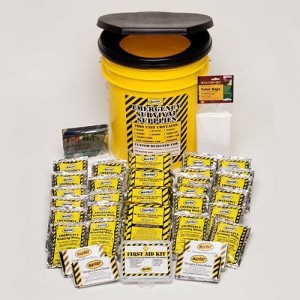 one person alive for twelve days. It includes food, solar blankets, water, dust masks, toilet disinfectant, light stick, wet naps, a flashlight/radio and cell phone charger, utility knife, and more.
one person alive for twelve days. It includes food, solar blankets, water, dust masks, toilet disinfectant, light stick, wet naps, a flashlight/radio and cell phone charger, utility knife, and more.
This kit is perfect for earthquakes, hurricanes, and almost every other kind of emergency you can think of. Be prepared!
Emergency Survival Kit Bucket – Deluxe – 4 Person
Earthquake Preparedness
August 30, 2011 by admin
Filed under
Plate tectonics affect the entire world and, just because you don’t think you live on a fault line, don’t expect to be safe from the ground-shaking motion of an earthquake.
Earthquakes shake everything if they’re strong enough. They can bring down buildings, crack roads, start fires and floods, and so much more. As of yet, there is not a warning for earthquakes before they hit you. If you think ones happening, better be safe than sorry.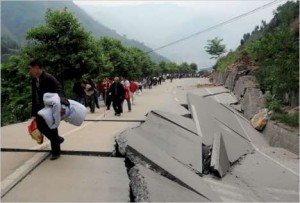
So what should you do if the ground starts rocking?
First off, unless you live in an old adobe house, don’t go for the doorway (unless there isn’t a door there, anyway). Modern homes are built differently. The best method is the one we grew up with: duck and cover. If you have a sturdy table, desk, or something similar, get underneath it, curl up, and put your hands over your neck and as much of your skull as possible. This prevent falling debris from striking the most delicate part of your body.
After the shaking has stopped, grab family, pets, and emergency supplies, and get out of the house. You don’t know if the structure of your shelter was compromised, or if the quake caused a fracture in a gas-line. Hopefully, you already have a fire extinguisher on hand just in case of this situation. Go turn off the gas line if you are able.
Electricity may be down, so you’ll definitely need a source of light. Candles may suffice for some, but an aftershock (which is inevitable after any large quake) may cause the candle to tip and start a fire. It is better to have a lamp or flashlight. Many companies make crank or solar-powered radios and flashlight combinations, that also charge cell phones, but if you don’t have one of these, make sure you have extra batteries in your emergency kit.
A first aid kit is a necessity, as well. Things are bound to fall during a quake, and people are bound to be under them. Make sure everyone stays hydrated, but use water you know is purified in case the water pipe leaked as well. There are plenty of water purification supplies that will make any water drinkable.
You’ll need food rations, as well. If power goes out, then you won’t have a stove or refrigerator. You’ll need food that doesn’t perish.
Another good idea for your earthquake emergency kit is a whistle or flare of some sort, something to get the attention of rescue workers in case you get trapped in the debris.
No one is ever truly prepared for an earthquake, but it’s better to have something now than regret not having it later.
Hurricane Preparedness
August 30, 2011 by admin
Filed under
Hurricanes aren’t a rare thing: they can be deadly and destructive.
On average, five hurricanes strike the US coastline in a three year period. Two of these five are hurricane category 3 hurricanes (aka “intense”) and they kill approximately 50 to 100 people.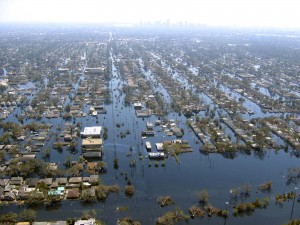
A hurricane is like a tornado in the fact that it’s a cycle, but it’s a tropical version. It is a low pressure system that incorporates thunderstorms, high-speed windows, and overall chaos.
You need to understand what the warnings mean for a hurricane. These alerts should come through via radio, news, or phones. They can be:
Tropical Storm Watch: This means the right conditions have been met that could possibly create a storm. It will specify the area, and the watch can last 48 hours.
Tropical Storm Warning: Tropical storm conditions of 39mph to 73mph are expected to be met in the next 36 hours. Have your emergency kit packed up and your hurricane safety plan on hand.
Hurricane Watch: The sustained winds of 74+ mph are expected. They try to give you a 48 hour warning beforehand. If possible, head inland with your most important documents and hurricane emergency kits with you. Let friends and family outside of your area know what you are doing.
Hurricane Warning: The 74+ mph winds have been met, and they expect a hurricane. They try to give it in advance. If you are in the specified location, try to head somewhere unaffected. Know where you friends and family are, and let them know where you are and where you are going.
The combination of high winds and flooding make hurricanes devastating. This is why it is important to keep up on hurricane preparation with supplies like first aid kits, food rations, and water purification supplies. Also consider having a crank-powered radio and flashlight. Many charge cell phones, too, so you can stay in touch with your family or friends.
You can never be completely prepared, but you can try. Make sure you won’t be left stranded if a hurricane heads your way.
Tornado Preparedness
August 30, 2011 by admin
Filed under
Tornadoes are considered one of the most quick and violent natural disasters than can affect you. They stem from conflicting temperatures hitting in the atmosphere and can arrive without warning at all.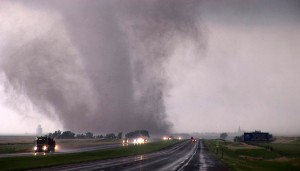
The funnel that hits the ground can have winds reaching 300 miles per hour, and you never know how fast a tornado is going, or where it will go next, or even how long it will last. It can pick up debris and toss them at someone who thinks they are safe without warning. They can rip apart homes, destroy cars, animals, and any kind of life. They can even throw a straw of hay through a tree.
Even if you think your tornado safety plan, survival kit, and preparation is good enough, nothing will get you ready for it. But you can try.
The most important thing to remember: the peak tornado season is different for everybody. The southern states will experience tornado season March through May, while the northern states will experience it late spring through early summer (usually April-July). While they have a pattern of arriving between 3-9PM, don’t count on it. They are so dangerous due to their unpredictability.
When a tornado alert comes through via radio, news, or phone, make sure you know what it means. “Tornado watch” I just what it sounds like: a tornado is possible in these weather conditions, so keep one eye on the sky at all times. Have a tornado survival kit nearby, and have your plan in action.
A “tornado warning” means that a tornado has been spotted. You need to get to safety immediately. Grab your survival kit, family, pets, and go for shelter (if you have the time).
There are a few simple ways to be prepared: keep wind chimes outside of your house in varying phases across your property. The sound can alert you before a news alert comes through.
Keep a first aid kit in your home at all times, as well as gear to board up windows, such as lumbar. Stay inside your shelter long after you think the tornado has passed, because there is the “eye of the storm”: that moment when you are in the funnel.
Power outages happen often due to tornadoes. A good way to prepare for this is to have a little bit of everything on hand, which can be found in kits or separately. These are things like: crank-powered flashlights and radios, food rations, water purification supplies, general tools like hatchets, and anything you’ll need for pets and children.
When adding your personal items to a tornado emergency kit, make sure to include prescriptions and medications that your family needs. Try to make a checklist of items that are necessary, including the urgent items you need to grab on the way out the door.
Flood Preparedness
August 29, 2011 by admin
Filed under
When it comes to floods, you truly never know what kind of damage will ensue. Will power go out? That means everything in your refrigerator will perish, so you’ll need food rations and a way to drink safe water. What about heat? Thermal blankets, waterproof matches, and extra clothing is necessary.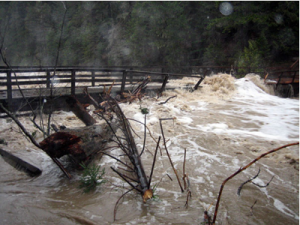
But there’s more to it than just that.
When a flood happens, the warning comes (via radio, phone, or news) in multiple terms. It could be a “flood forecast”, which just means the rainfall is so heavy, that rivers and streets can overflow. A “flood warning” means that a river, lake, or something similar has overflowed. A “flash flood” means that a flood can be quick. This is a common thing in places like foothills of mountains, where the rainfall builds up in the brushes, but when the dirt gives way, all that water comes down at once. If a “flash flood watch” turns into a “flash flood warning”, you need to be ready to move when the time comes.
Make sure you have lights, something that uses a battery. Now, you can purchase lights and radios that use power from a hand crank or solar, which also can charge cell phones and similar items. Make sure you have sandbags, plywood, sheeting, and lumbar near your house so you can protect it if a flood is coming.
Make sure you know what your insurance plan covers for floods, as well. Even though insurance will replace tangible items, keep a water-proof and fire-resistant safe for birth certificates, photos, and any other things that are irreplaceable.
If you are asked to evacuate during a flood, it is important to think of safety: turn off utilities, switches, and valves to the house. Know of a safe place to go, and make sure to inform friends and family where you are headed. Remember: roads flood. Do not drive in a flooded street, because, once a tire can’t touch the ground, you will end up just floating with the flow.
Keep an eye out for mud slides, electrical wires, street poles, and any other possible hazard.
For more tips on flood preparation, check out several books and items listed below. There disaster survival kits as well as emergency supplies that will help you in your time of need.










